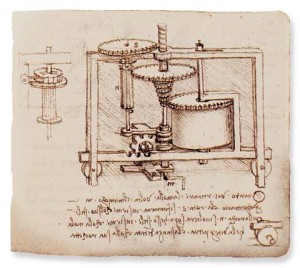Leonardo Da Vinci and the F0-F1 ATPase
![]() Offspring #2 (O2) and I spent last weekend visiting the Da Vinci Experience exhibit at San Diego’s Air & Space Museum. The exhibit is engineer’s heaven: large wood models based on and inspired by LDV’s drawings. Gears, crankshafts, pulleys. O2 was interested in the military stuff: catapults, the tank , a mobile bridge. I did not know LDV designed a mobile bridge:
Offspring #2 (O2) and I spent last weekend visiting the Da Vinci Experience exhibit at San Diego’s Air & Space Museum. The exhibit is engineer’s heaven: large wood models based on and inspired by LDV’s drawings. Gears, crankshafts, pulleys. O2 was interested in the military stuff: catapults, the tank , a mobile bridge. I did not know LDV designed a mobile bridge:
There were a lot of gear exhibits, which I did not photograph unfortunately. Efficient and accurate transfer of motion was a big thing with LDV. Another thing I did not know: he probably invented the ball bearing.
So when I saw Nature’s special section on membrane protein biophysics , something clicked. We normally associate the rotary mechanism and gear transfer with human engineering, rather than with nature. Maybe it is human arrogance having invented the wheel and later the gear transfer as a form of locomotion. No other creature uses wheels for locomotion (but see below), hence we are smarter than nature since we came up with an engineering solution She did not.
Only that pride is misplaced. Two of the most common protein complexes in nature rely on a rotary motor, gears, torque, kinetically efficient transfer of motion, and all that jazz that powers our vehicles. One is the bacterial flagella: technically bacteria do use wheels for locomotion then (although the transfer of motion they use it more like a ship’s corkscrew, another LDV first). The other is the F0-F1 ATPase. It is a mushroom shaped complex motor embedded in our mitochondrial membranes and is powered by the electric potential across the membrane to generate Adenosine Tri Phosphate. ATP is the universal coin of energy in the living cell, and the F0-F1 ATPase generates 32 out of every 36 ATP molecules which cells need to exist. It is a heavily researched complex and intricate piece of machinery, central to almost all life. The F0-F1 ATPase’s gear-transfer mechanism is described in the article as “… composed of two rotary motors/generators that are mechanically coupled by a central rotor and an eccentric stator“. (Junge et al Nature 459, 364-370). And here is a movie explaining F0-F1 mechanics in detail. LDV would have liked this, I’m sure. He might have even broken into a Mona Lisa smile, or gone into a Mona Lisa Overdrive.
Update: Harvard University removed this video from Youtube. As to the whys and wherefores, see here.
Junge, W., Sielaff, H., & Engelbrecht, S. (2009). Torque generation and elastic power transmission in the rotary FOF1-ATPase Nature, 459 (7245), 364-370 DOI: 10.1038/nature08145






















Its been years since I have seen the SD air and space museum. Still looks the same Lol.
N